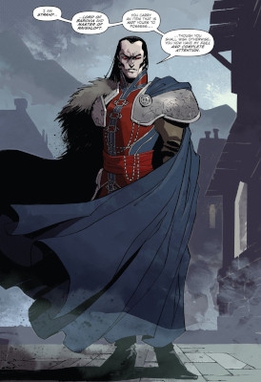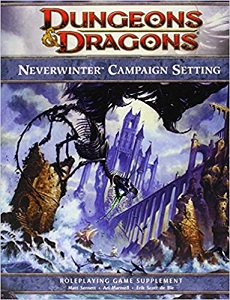 | |
| Genre | Role-playing game |
|---|---|
| Publisher | Wizards of the Coast |
Publication date | September 2007 |
| Media type | |
| ISBN | 978-0-7869-4731-7 |
The Grand History of the Realms is a supplement to the 3.5 edition of the Dungeons & Dragons role-playing game.
 | |
| Genre | Role-playing game |
|---|---|
| Publisher | Wizards of the Coast |
Publication date | September 2007 |
| Media type | |
| ISBN | 978-0-7869-4731-7 |
The Grand History of the Realms is a supplement to the 3.5 edition of the Dungeons & Dragons role-playing game.
The Grand History of the Realms is an accessory for the Forgotten Realms which presents a definitive in-game history of the setting from the dawn of recorded history through the ancient days of Netheril and the Fallen Kingdoms, to the Time of Troubles and the upheavals of the present time in the setting. The text is accompanied by anecdotes, diary entries, letters, and historical texts created by famous personalities of Faerun, and an extensive and comprehensive timeline including a sneak peek into upcoming events.
The Grand History of the Realms was written by Brian R. James, Ed Greenwood, George Krashos, Eric L. Boyd and Thomas M. Costa, and published in September 2007. Cover art was by Todd Lockwood, with interior art by Kyle Anderson, Glen Angus, Steven Belledin, Matt Cavotta, Rafael Garres Cervantes, Ed Cox, Daarken, Wayne England, Jason A. Engle, Emily Fiegenschuh, Carl Frank, Ralph Horsley, Andrew Hou, David Hudnut, Jeremy Jarvis, Dana Knutson, Ginger Kubic, Stephanie Law, Howard Lyon, David Martin, Dennis Crabapple McClain, William O'Connor, Lucio Parrillo, Jim Pavelec, Michael Phillippi, Steve Prescott, Wayne Reynolds, Ron Spencer, Stephen Tappin, Joel Thomas, Derek Thompson, Franz Vohwinkel, Eva Widermann, and Sam Wood.
The book originated out of a fan project where James collated all Forgotten Realms events "according to their in-setting date". [1] In the foreword of the book, Richard Baker wrote: [2]
This was something unprecedented for us; for the first time in my long experience with TSR and Wizards of the Coast, we accepted an unsolicited, fan-created piece of work, originally available on the Internet, and put it out in our product schedule. The Grand History of the Realms is therefore not just an excellent Forgotten Realms resource, but also a truly revolutionary product and process for us. It's a sign that you, the readers and players of the Forgotten Realms campaign setting, are taking control of the creative process. [...] The Realms are more than what we say they are — they're what you say they are, too.
The original fan project was a 100-page PDF. The published book added "sidebars throughout, featuring commentary from Ed Greenwood and many other official Realms designers. These sidebars explain campaign features, discuss historical events, give first-person accounts of events as recounted by characters in the Forgotten Realms, and generally serve to round out the short descriptions of every notable event that has occurred in official products". [3] This book acts as "a last hurrah for the setting before major changes (such as the Spellplague) implemented with 4e". [1]
John Baichtal, for Wired , wrote "even if you're not a Realms-head, this book has tons of value. Just as a guide for world creation, it's a great example. It forces you to think, how did this race or that empire become great? What became of it when its time passed? My only complaint about the book is the lack of bibliographical references. If the events of a novel are mentioned, might a footnote not be helpful for readers interested in learning more?" [4]
Curtis D. Carbonell, in the book Dread Trident: Tabletop Role-Playing Games and the Modern Fantastic, wrote "The Grand History is important because it represents how a shared imaginary universe becomes realized through the combination of analog/digital tools made available to the public. [...] This reference-designed gametext represents the FR at its most robust, combining a history that stretches across three editions". [1]
Kevin Kulp, game designer and admin of EN World, wrote "this book is a must-buy for anyone interested in the Forgotten Realms; there is literally no other publication that comes close to pulling so many disparate threads together into one cohesive, easily understood timeline. It's also extremely useful for DMs who homebrew their campaigns instead of playing in the official campaign setting. Many games lack the weight of history simply because the DM has neither time nor energy enough to build the many events needed to add texture to their world. [...] The Grand History of the Realms is a great example for how a DM can add that sort of detail into a game, and it provides perspective for the massive sweep of a campaign's history. [...] Value has been added over the original free PDF through maps, art, and sidebar commentary". [3]
Forgotten Realms is a campaign setting for the Dungeons & Dragons (D&D) fantasy role-playing game. Commonly referred to by players and game designers as "The Realms", it was created by game designer Ed Greenwood around 1967 as a setting for his childhood stories. Several years later, it was published for the D&D game as a series of magazine articles, and the first Realms game products were released in 1987. Role-playing game products have been produced for the setting ever since, in addition to novels, role-playing video game adaptations, comic books, and the film Dungeons & Dragons: Honor Among Thieves.

Planescape is a campaign setting for the Dungeons & Dragons fantasy role-playing game, designed by Zeb Cook, and published in 1994. It crosses numerous planes of existence, encompassing an entire cosmology called the Great Wheel, as developed previously in the 1987 Manual of the Planes by Jeff Grubb. This includes many of the other Dungeons & Dragons worlds, linking them via inter-dimensional magical portals.
In the fantasy role-playing game Dungeons & Dragons, an Outer Plane is one of a number of general types of planes of existence. They can also be referred to as godly planes, spiritual planes, or divine planes. The Outer Planes are home to beings such as deities and their servants such as demons, celestials and devils. Each Outer Plane is usually the physical manifestation of a particular moral and ethical alignment and the entities that dwell there often embody the traits related to that alignment.
Mystra is a fictional goddess in the Forgotten Realms campaign setting for the Dungeons & Dragons fantasy role-playing game.
Abeir-Toril is the fictional planet that makes up the Forgotten RealmsDungeons & Dragons campaign setting, as well as the Al-Qadim and Maztica campaign settings, and the 1st edition version of the Oriental Adventures campaign setting.

The planes of the Dungeons & Dragons roleplaying game constitute the multiverse in which the game takes place. Each plane is a universe with its own rules with regard to gravity, geography, magic and morality. There have been various official cosmologies over the course of the different editions of the game; these cosmologies describe the structure of the standard Dungeons & Dragons multiverse.

Count Strahd von Zarovich is a fictional character originally appearing as the feature villain in the highly popular Advanced Dungeons and Dragons adventure module I6: Ravenloft. Later, this character and his world would be explored in follow-up modules, novels, and the Ravenloft campaign setting. Within this setting, Strahd is the first and best-known of Ravenloft's darklords. He is a powerful ancient vampire. He is also a master necromancer, a skilled warrior, and the unquestioned ruler of the domain of Barovia.

D&D Adventurers League is the organized play association for the Dungeons & Dragons (D&D) roleplaying game which is officially administered by D&D's publisher, Wizards of the Coast. It was rebranded with the launch of D&D's 5th Edition in 2014. Prior to 2014, it was known as the Role Playing Game Association Network. The organization was originally established by D&D's previous publisher, TSR, Inc., in 1980.

The Forgotten Realms Campaign Setting is a role-playing game sourcebook first published by TSR in 1987 for the first edition of the fantasy role-playing game Advanced Dungeons & Dragons that describes the campaign setting of the Forgotten Realms. It contains information on characters, locations and history. Various revised and updated editions have been produced over the years.

The Forgotten Realms Atlas was a book produced by Karen Wynn Fonstad and provided detailed maps of the Forgotten Realms, a fictional setting in the Dungeons & Dragons fantasy role-playing game.

The Forgotten Realms Campaign Guide is a supplement to the 4th edition of the Dungeons & Dragons role-playing game.

The Dungeon Master's Kit is a box set released as part of the Essentials line of the 4th edition of the Dungeons & Dragons role-playing game. It is intended for primary use by the game's Dungeon Master.

The Sundering refers to two events that occurred in the fictional timeline of the Forgotten Realms campaign setting of the Dungeons & Dragons role-playing game. It is also the title of both a series of novels published by Wizards of the Coast and a multimedia project Wizards of the Coast used to transition Dungeons & Dragons from 4th Edition to 5th Edition. This project explored the Second Sundering story and included the aforementioned book series, the free-to-play mobile game Arena of War developed by DeNA and an adventure series for the 4th Edition D&D Encounters program.

Neverwinter Campaign Setting is a supplement to the 4th edition of the Dungeons & Dragons role-playing game.

Menzoberranzan: City of Intrigue is a system-neutral supplement to the Dungeons & Dragons role-playing game published towards the end of 4th edition.

Ed Greenwood Presents Elminster's Forgotten Realms is an edition-neutral sourcebook for the Forgotten Realms published during the 4th edition of the Dungeons & Dragons role-playing game.
Wolves of Freeport, formerly named OneBookShelf, is a digital marketplace company for both major and indie games, fiction and comics. In 2023, OneBookShelf merged with Roll20 to become Wolves of Freeport. OneBookShelf itself was formed by the merger of RPGNow and DriveThruRPG in 2006. The company's e-commerce platforms host content from individual sellers, indie creators and major publishing companies such as Chaosium, Fantasy Flight Games, White Wolf, and Wizards of the Coast.

Icewind Dale: Rime of the Frostmaiden is an adventure module with themes of survival, horror and fantasy for the 5th edition of the Dungeons & Dragons fantasy role-playing game.

Actual play, also called live play, is a genre of podcast or web show in which people play tabletop role-playing games (TTRPGs) for an audience. Actual play often encompasses in-character interactions between players, storytelling from the gamemaster, and out-of-character engagements such as dice rolls and discussion of game mechanics. The genre emerged in the early 2000s and became more popular throughout the decade, particularly with the 2015 debut of Critical Role, an actual play webseries featuring professional voice actors.
Dungeons & Dragons: Adventures in the Forgotten Realms is an expansion set for Magic: The Gathering (Magic) released in July 2021. The world of the Forgotten Realms was created by game designer Ed Greenwood around 1967 as a paracosm for his childhood stories and premiered as a campaign setting for the Dungeons & Dragons (D&D) fantasy role-playing game in the Forgotten Realms Campaign Setting (1987). This expansion set is the third collaboration between Magic and D&D; both teams are part of Wizards of the Coast.
{{cite book}}: CS1 maint: others (link)